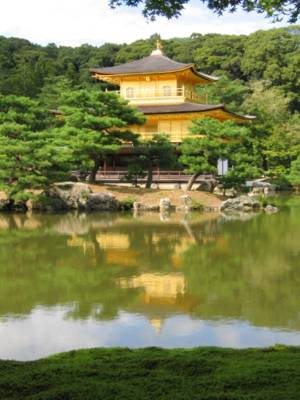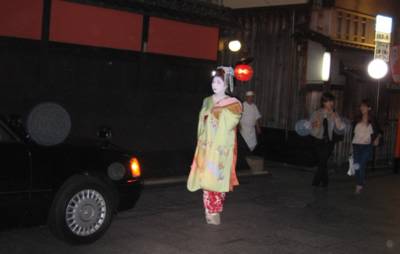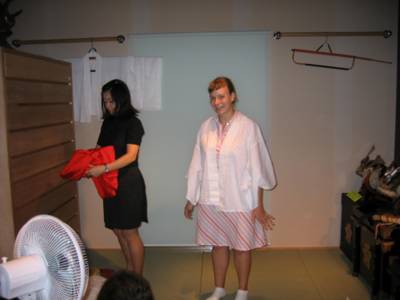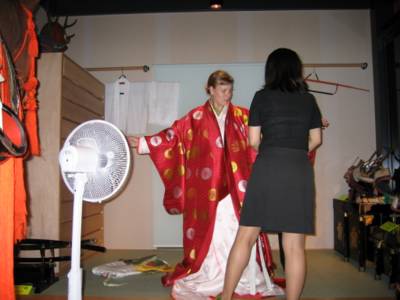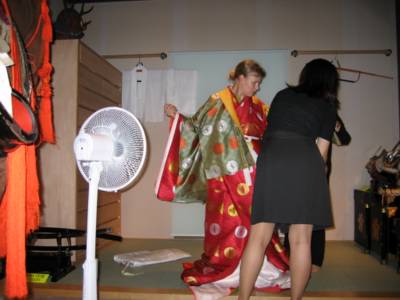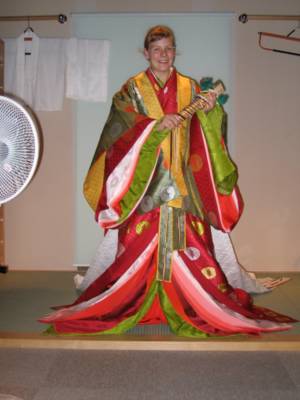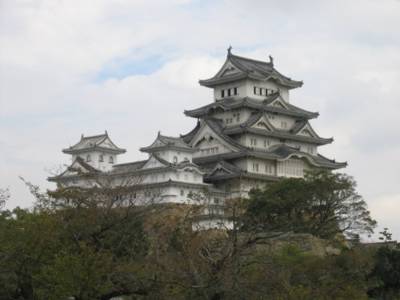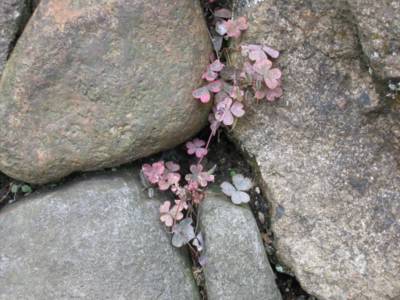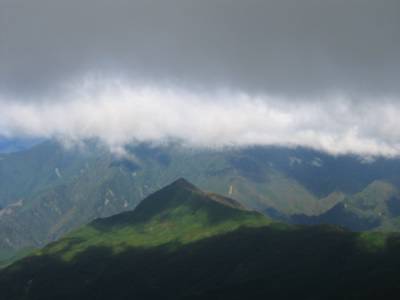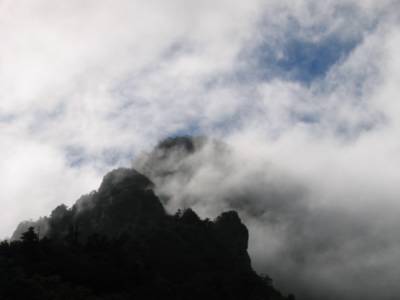Onegaishimasu
The Amazing Adventures of Jon and Nancy
Wednesday, September 29, 2004
Tuesday, September 28, 2004
Feeling old in Kyoto
Kyoto is city of kept secrets. Dark tunnels and imposing gates mark the entrance to even the most touristed sites. Although you take the bullet train into town, you must still bow your head entering the ancient capital's myriad temples and shrines, lest you trip on the raised entrance. There is something of the old ways left in Kyoto.
You wouldn't know it upon arrival. Kyoto Station is a cavernous steel and glass monument. A much-maligned building, it dwarfs the hundred-year-old tin-covered wooden structures below. From the top of the station you can make out two temples: Nishi Hongan-ji and Higashi Hongan-ji. Headquarters of the True Pure Land sect of Buddhism, Nishi Hongan is a showcase of Japan's architectural and historic achievement. Higashi Hongan-ji, while less important historically, is one of the biggest wooden structures on earth, every bit as fantastic as that sounds. Viewed as one of the same beast, the station and the temples offer a basic metaphor for the country as a whole and Kyoto in particular.
Alex Kerr writes: "In contrast to Europe... change to came to China, Japan and Southeast Asia in a truly precipitous fashion. What's more, these changes were introduced from a completely alien culture. Consequently, modern clothing and architecture in China and Japan have nothing to do with traditional Asian culture. Although the Japanese may admire Kyoto and Nara, and consider them beautiful, deep in their hearts they know that these places have no connection to their modern lives. To put it bluntly, these places have become cities of illusion, historical theme parks."
For 500 yen we bought a bus card and entered the park.
The first place we visited was Rokuon-ji Temple, location of Kinkaku, the Golden Pavilion. From the station it was a forty minute bus ride through a vast urban wasteland identical to that of any city in the country. It was worth the effort though.
I'm certain that the first glimpse of gold shimmering through the leaves dilated my pupils. Seeing the entire gold building hovering on the reflecting pond took my breath away. The grounds were awash with tourists, but even that did not detract from the pavilion's serene aura of power and wealth.
After the Golden Pavilion there wasn't much to see on the temple grounds. The small paths leading into the forests were closed to the public; as tourists we were corralled into a gift shop before exiting. We quickly bypassed the manic kitsch characteristic of Japanese gift shops and hopped on a bus bound for Ryoan-ji Temple, whose rock garden is likely one of the better places in the world to sit and contemplate the meaning of nothing.
Entering the temple grounds there was a picturesque pond which until recently was home to a flock of mandarin duck. From there the pathway headed uphill, along a stone stairway toward the main temple and location of the garden.
At first I was disappointed. "This is it? There's nothing else here?"
I sat down with the other tourists and stared at the garden, fifteen rocks arranged in a bed of white gravel. A tiled yellow wall surrounds the garden and beyond that is a mixed forest. Clouds passed over the sun, softened the shadow effect. The crowd's mood softened as well. People spoke in hushed tones. The sun returned and harsh light fell onto the white gravel. Conversation became more animated. After a while I felt relaxed and able to think clearly. Simple as it is, the garden at Ryoanji works a type of magic.
That night a different sort of magic appeared. There was an hour to kill before the last train to Kobe so went to Gion, the ancient geisha district. We didn't expect to see anything exciting, only to walk the car-less streets and admire the classic wooden buildings, red lanterns swaying in the summer breeze.
Walking back to the bus stop we noticed a small crowd gathered in front of a building. A group of taxis sat idling. There was a flash of kimono from behind a curtain. In a flurry of activity eight or nine geisha emerged, as perfect as Van Gogh's Sunflowers. Three or four hopped into a taxi and disappeared down the street; one dressed in purple walked this way and that, unsure of where she was headed; a pair ducked into the building next door; one simply walked into the night. Then it was over.
Geisha make even the Japanese feel foreign. They are mysterious, powerful, beautiful and cultured, a link to an ancient way of life and an outdated way of doing things. That it is still possible to see them going from one party to the next speaks volumes. Although the exterior may be shiny and modern, this is an ancient country with ancient ways. Hopefully those ways continue: I never want to consider Kyoto a theme park.
Yann Martel asks and then answers:
Why do people move? What makes them uproot and leave everything they've ever known for a great unknown beyond the horizon? Why climb this Mount Everest of formalities that makes you feel like a beggar? Why enter this jungle of foreignness where everything is new, strange and difficult?
The answer is the same the world over: people move in the hope of a better life.
Monday, September 27, 2004
As mentioned, Kokoen is a strolling garden composed of nine unique areas separated by walls and connected by walkways. From the garden of the lord's house you walk through a roofed corridor into the garden of seedlings. There is a tea house garden where five dollars gets you a cup of tea and a piece of cake, a deciduous garden, an evergreen garden, a flatly landscaped garden, a flower garden and even a garden with a hill and a pond. Ours was more of a gallop than a stroll, but still we enjoyed the scenery.
We ended up in a Turkish restaurant some way from both the castle and the garden. Nancy ordered falafel while I went for the chicken pita. Delicious!
Still licking our chops, we headed for the Hyogo Prefectural Museum of History. The women at the desk guided us toward the permanent collection, an engrossing account of the development of Japanese culture starting with the Jomon period. We saw ancient pottery, ancient weapons and tools, learned about the development of rice farming as well as the influence exerted by the Chinese and Koreans.
The temporary exhibition, entitled "Buddha of Wood, Buddha of Silk", didn't have any English translations, and probably would have been over my head anyway. Spend a while in Japan and you get Buddha'd out sooner or later. Luckily an announcement for the trial display distracted us: hurry, and one lucky boy or girl gets to try on the samurai armour or the twelve layered kimono! We jankened and Nancy got to try the kimono, all fifteen kilograms of it! She looked like she just stepped out of an Edo era castle, ready to compose a haiku or drink some tea or something. She also looked absolutely stunning.
Sunday, September 26, 2004
Nancy and I went on a trip this weekend. We left Thursday night for the beautiful Holiday Inn Express Kobe, a forty minute train ride east of Himeji Castle. I would have rather stayed in the castle, but thanks to the power of google we got a deal on the hotel. I can't even imagine the going rate for a night at Himeji.
According to the literature - actually, the pamphlet we got at the Himeji City tourist information center where you can borrow a beat-up peddle bike for free - the castle represents a heron in flight, hence the famous nickname White Heron Castle (the Japanese may be renowned poets, but no one ever accused them of being imaginative). It was completed in the early 17th century, which makes it much older than Canada. Like Canada, Himeji is enourmous and breathtaking.
Entering the castle grounds you must walk 300 hundred meters along a corridor where soldiers and maids once slept. You pass through a courtyard before entering the main keep, a six story monolith supported by two massive pillars, one of them the corpse of a 700-year-old cypress tree said to bestow long life to those who touch it. Can you believe Nancy licked it?
The view from the top was the same as the view from the top of most Japanese castles: overwhelmingly gray with the odd flash of neon. You see, in feudal Japan towns often sprung up around castles. Samurai lived close to the castle where they could conduct their administrative duties while merchants and tradespeople lived scattered around the area. When Japan modernized, the old castle towns exploded into monstrous cities. Kind of like what happened to Godzilla.
After Himeji, we headed to the Kokoen, or Nine Gardens. But its getting late, and Nancy hasn't put her pictures up yet, so more on that tomorrow.
Monday, September 20, 2004
I had undokai on Sunday. This year I actually understood some of what was going on. Granted the four-man team chicken fights were still as bizarre as Bjork’s new album, it was fun watching the grade nine boys pile-driving their testosterone deprived grade seven counterparts while the teachers cheered in reckless abandon. The human pyramid went off without a hitch and only two kids landed on their heads during the balance-the-little-kid-by-the-legs-and-shoulders-as-high-up-in-the-air-as-you-can event. There was still way too much marching and crying for my taste, but overall this year undokai was way more normal than last year.
After undokai there was an enkai, which is basically an office party except it happens twice a month and it’s pretty much mandatory.
One thing I noticed while waiting for the party to start is the amount of power in the principal’s hands. Everyone has been working really hard for two weeks getting the undokai together, finally it’s finished, everyone has pitched in and helped clean up, it’s 6 p.m. on the Sunday of a long weekend, and what does the staff do but sit in the office and wait for half an hour doing absolutely nothing but waiting for the principal to give a two minute speech about the weather (it really was about the weather) so they can leave for the enkai which they don’t want to go to but have to because the principal wants them to. This seemingly insane behaviour has to do with the bonus system in Japan, where up to half your salary comes from a twice yearly bonus. It’s a pretty screwy system, which totally undermines any power the union might otherwise lay claim to. Good for business though.
The enkai was zany as always. I ended up sitting beside this dude whose only English was, “I am Buddhist, secret Buddhist. You are great.” It made for interesting, if limited, conversation.
Anyway, enjoy the pictures.
Wednesday, September 15, 2004
On August 21 Nancy and I went to a shamisen concert at Third Eye, a coffee/ Southeast Asian goods/ drum shop in Togano.
It started with too-fast Japanese
bamboo heat, Indonesian wood carvings,
incense and beads, low rumble djembes,
tied-died sarongs, NORML T-shirts,
Nepalese toques, the calm of fresh coffee,
Sato Michihiro and the first stroke
of the top string.
Ding-ding ding-ding-ding ding-ding
clack ding-ding clack-clack ding
plectrum, body, string ding-ding
Sato-san Buddha-faced, dark, hard
rosewood body faced clack ding-ding.
“This song, sung by geisha,
was later absorbed into kabuki.
Lost love and tragic death.
Listen.”
The silence between.
The intense focus and controlled noise,
the slow-fast-faster-stop
of a frog, hopping.
An hour doesn’t last long.
"Encore!"
“Whoop like this and
stomp like this. Ready?
Go!” That generations old farm house
shook in the night. We laughed
and sweated with cicada screech-song
and tropical mountain heat.
Stop:
the final stroke
of the bottom string.
Tuesday, September 14, 2004
It’s undokai time. Normally translated as sports day, undokai is more like a cross between a high school hazing circa 1984 and games time at the family picnic. In other words, undokai is weird.
My favourite event has to be the human pyramid, wherein five 13-year-old boys lock arms so that three 12-year-old boys can shimmy up their backs so that one 11-year-old boy can perch himself on top, after which the entire pyramid stands up and lowers itself back down. A magnificent display of teamwork when all goes to plan, which it does with surprising regularity, the human pyramid is still an idiotic thing for 12-year-old boys to be doing on school time.
My next favourite event is the wedge-your-butt-crack-into-neighbours-knee-forming-a-big-circle-and-everyone-falling-down-with-a-whoop-and-a-hollar event. It is, sadly, exactly as it sounds.
The kids also elect team leaders whose job it is to run chant practice. The chant is an elaborate affair involving an empty oil barrel painted the team colours, dancing and yelling, clapping and singing. It runs about five minutes, is usually broken into five or six parts and is taken very, very seriously. Even the teachers cry when they lose.
Like I was saying, undokai is weird.
Monday, September 13, 2004
It was supposed to be so easy.
We would wake up early, get everyone in the car, drive to Ishizuchi-san, eat some udon, climb the mountain, climb back down, get everyone in the car and be back in Sakawa in time for supper. But Sally forgot to put gas in her car, and so she had to drive back eighteen kilometers to fill up. The rest of us ate our udon – handmade and garnished with freshly picked mountain mushrooms – and waited the hour it took.
As we were leaving, however, the udon restaurant owner warned us we better hurry if we wanted to be off the mountain by six, because, we assumed, that was when the sun would set. It was only one, though, and the guidebook said four hours to do the hike. We assumed we would have lots of time.
The drive up the mountain was harrowing and beautiful. We parked, zipped past the Shinto shrine and started the hike through pristine mixed forest. The views were spectacular. Clouds formed in the valley and blew up the side of the mountain to join their rain cloud cousins in the sky, mountain valleys filled the horizon and in the far distance the Inland Sea shimmered blue and infinite.
The top of the mountain was freezing cold, extremely windy and totally enveloped in cloud. Visibility was about twenty meters, which gave the impression that we were all alone on a platform on top of the world. A Shinto priest showed us his pictures of sunrise and sunset, the kind you see in National Geographic and dreams. We shared some chocolate and nuts and headed back down.
None of us had anticipated how challenging the hike would be. We were exhausted and the return walk took much longer than expected, especially since the final twenty minutes were in near total darkness. It was quarter to seven when we finished, and so we quickly hopped in our cars to drive back home. Except the gate was locked (when you assume, you make an ass out of you and me – isn’t that how it goes?).
After deliberations, we decided ask for help. A wonderful woman offered to cook us supper, but we convinced her that was unnecessary, so she gave us a bag of chocolate instead. She also sent her daughter to lead us the hour-long drive through the cloud wrapped back road, toward the main highway. The road was littered with debris from the typhoon and visibility was near zero. I’d been on similar roads before, and didn’t mind too much, but the other driver has only been in Japan and that was her first real driving experience. She cried when it was over.
We made it home safe and sound. Tired as a bag of bones and hungry as bears, but otherwise fine. Thanks to the kindness of strangers and some good luck, no one got hurt. Next time, we need to listen to the local warnings. That, and remember gas. Then it really will be easy.
Wednesday, September 08, 2004
Masanobu Fukuoka says:
"Many people think that when we practice agriculture, nature is helping us in our efforts to grow food. This is an exclusively human-centered viewpoint. We should instead realize that we are receiving that which nature decides to give us. A farmer does not grow something in the sense that he or she creates it. That human is only a small part of the whole process by which nature expresses its being. The farmer has very little influence over that process, other than being there and doing his or her small part."
Tuesday, September 07, 2004
Robin: "Holy typhoons and earthquakes Batman! How can they possibly survive?"
Batman: "Because Robin, they have nerves of steel. And they've started drinking wheatgrass juice."
R: "Heavens to Betsy! Why? Why!?!"
B: "Because Robin, although it may taste like lawnmower clippings, it gives them the boost they need."
R: "So they'll be all right then?"
B: "I think so Robin. I think so."
My entry to the town newsletter.... (I apologize for the length!)
Tons of Typhoons
This year Kochi-ken has had so many typhoons. The weather is becoming so strange. Someone told me that 30 years ago Kochi had so much rain that crops (rice and fruit) could not grow. Last summer was cooler than usual and this spring’s rainy season was only slightly rainy. Now, during typhoon season, the typhoons don’t seem to stop coming.
Saskatchewan, Canada is in the same situation. Usually in the spring and summer there is so little rain that the farmers are constantly worrying about their crops. Summer has been, for as long as I can remember, hot and very dry. However, this summer, it was cool and there was a lot of rain. The weather everywhere is changing. Perhaps, the change in weather is only part of a cycle and someday it will return to normal. Or it is global warming that is melting glaciers and just generally warming up the entire earth? Maybe it is due to the deterioration of the O-zone layer particularly over Antarctica?
Some people believe it is the environment getting angry for the way we treat it. Typhoons and other storms is the environment fighting back. Perhaps the earth is tired of being abused by car exhaust, garbage, sewage, pavement, etc. Maybe it is time that we start looking at ways to conserve energy and be less wasteful by walking or carpooling instead of driving alone everywhere and using less paper and plastic. I realize that this may seem like an impossible task but just think of a trip to the grocery store. When you buy a bottle of hairspray, dish soap, and 2 peaches, you end up with about 3 or 4 bags. One bag for the hairspray that is already covered in plastic, one for the dish soap, and another for the peaches if they aren’t already wrapped in plastic. Then, all of these items in separate bags are placed into another bag. I have noticed that Sun Plaza has started a reward system where if you ask for no bag, you can get a stamp. After collecting 20 stamps, you get a 500-yen coupon. A store in Canada has charges customers for plastic bags. This encourages people to reuse their plastic bags, or to buy a canvas bag for groceries. The hardest part is remembering to bring your bags with you to the store.
Typhoons are tropical storms that only occur in tropical or sub-tropical countries. Canada does not have typhoons. The closest thing to a typhoon in Canada is a blizzard. Blizzards occur in winter and involve snow, instead of rain, and winds of at least 40 mph. Blizzards are so severe that a person can only see less than 1 KM and they last for at least 4 hours. Driving a car can become impossible or very dangerous. Power outages can also occur. One of the most dangerous aspects of a blizzard is the low temperature (below –7 degrees). About 100 people die in Canada each year from blizzards or other snowstorms.
As I am sure you can tell, we got our new computer. Thus, we bring you pictures!
Today is typhoon number 18. It is also supposed to be a big one. Apparently on Sunday late at night, there were 2 earthquakes. The first one was 110 km off the coast of Wakayama and it did a lot of damage. The second one was 130 km off the coast of Kochi. It was larger than the first one but it did less damage. I didn't feel a thing.
In 2 more days, we can expect typhoon number 19. However, number 19 won't hit us as much. It is headed for Tokyo.
Yesterday the principal said that if it was typhooning, I was to stay at home. Yes! Finally I can stay at home when there is a typhoon instead of doing nothing at my BOE. However, my supervisor called me this morning to tell me that I had to go to the BOE. I feel ripped off. I would much rather there was no typhoon so that I could go to school and teach the students. The school that I was supposed to go to was a lot of fun on Monday. Also, I had a great lesson planned. For once, the teacher let me do everything. Oh well, I can study for my Japanese test. Study study study.
Monday, September 06, 2004
Not long ago, I started a blog that dealt with Japan and the environment. Rather than have it as a separate entity, I'm going to (occasionally) discuss those issues here. My apologies.
Nancy and I went snorkeling this weekend on the Otsuki coast, about a four hour drive from here. Another typhoon is on its way, though, so we didn't get to see the best reef, which is supposed to be as good as in Okinawa. We had to go in the bay where the fishing and diving boats exit and enter the Pacific.
We rented our gear from a dive shop, and then headed into the water. Since it was cloudy, we didn't think to wear sunscreen, and the water was warm enough that we didn't need a wetsuit, which was nice. The current was pretty wicked because of the waves raging in the ocean. Visibility was low, maybe 5 meters, and even though we didn't see much coral, there were a lot of tropical fish. We saw red fish, yellow fish and blue fish galore. Three hours flew right past, and now I have the sunburn of the lifetime.
Its so relaxing looking at fish, the time just flies right by. We're going to buy our own gear and probably head out again in October. Its hard to believe that just four hours south west of Sakawa you can visit a tropical ocean environment.
Friday, September 03, 2004
An example of Japanese inefficiency....
Just before lunch the secretaries rush into the teacher's room in a huff and request help with carrying the school lunch. Everyday there are the same amount of dishes and containers that need to be carried to the staff room. And everyday, all 20 teachers who are in the staff room plus the 3 secretaries go to carry about 5 containers. Some of the containers require 2 people. In all, at most, 9 people are needed. This leaves 14 people with nothing to do except to provide moral support.
One time, I didn't go because I feel that it is unnecessary for all 20 teachers to help. I got some bad looks and sensed some animosity. Now, I always go. If nothing else, it is a nice 4 minute walk through the school.
On the plus side, I guess it is good teamwork.....
Thursday, September 02, 2004
I am either getting a cold or my allergy is in full force today. I feel aweful. I have some medicine from the doctor in Canada that I was holding out on but I think tonight I will start taking it. I can't take this anymore! Hopefully it works quickly.
I have no classes today. I am not sure whether to be happy or bored. Having a class would definitely make the time go by faster. Oh well. I have been studying Japanese so much lately. My head is about to explode. I should take advantage of my free time but I don't think I can stuff very much more into my brain.
My friend, Y-san, tried to rally me up some classes. He asked all the English teachers if they have classes and when they told him they do, he attempted to convince them to bring me to class. He was trying to do me a favour I am sure but it was a bit embarrassing. Today, with the exception of 2 periods is test day so I don't feel too bad about not having class. Plus, my brain is still on holiday.
One of my teachers did get me to mark a whole bunch of the summer homework that she gave to the grade 7 students. It was the first time I have ever corrected any of the student's work so I was really happy to help out and it filled up about 1 hour and a half of my time.
On a side note: one of my students wrote a letter to Emma Watson (the H-girl from Harry Potter) and she wrote back. What is her name in the show again?
I love the rain when it starts up in the middle of the night, cools the house down to a nice not-tossing-in-your-own-sweat-while-you-sleep temperature, nestles you in the soft pitter-patter of happy fat raindrop dreams, silences the unending whirl-a-gig cicada screech-song, batters down the mosquitos biting and biting and biting. Then waking up and look! the heavens have come down for a visit, angelic whisps of cloud cling to mountain escarpments, the white and green of cedar punctured clouds delivering food for bamboo, shiitake, ferns, moss and lichens, the deep emerald mountains misty-eyed and otherworldy in the soft morning light. Later driving up and up and up Mount Kokuso on a BMW ad road, daydreams of swelled rivers, rolling waves and quiet pools, passing the time stuck behind a dumptruck rumbling and sputtering black fumes down the mountain into Susaki. Finally watching the rain falling and falling and falling, wanting outside and what I saw this morning.


